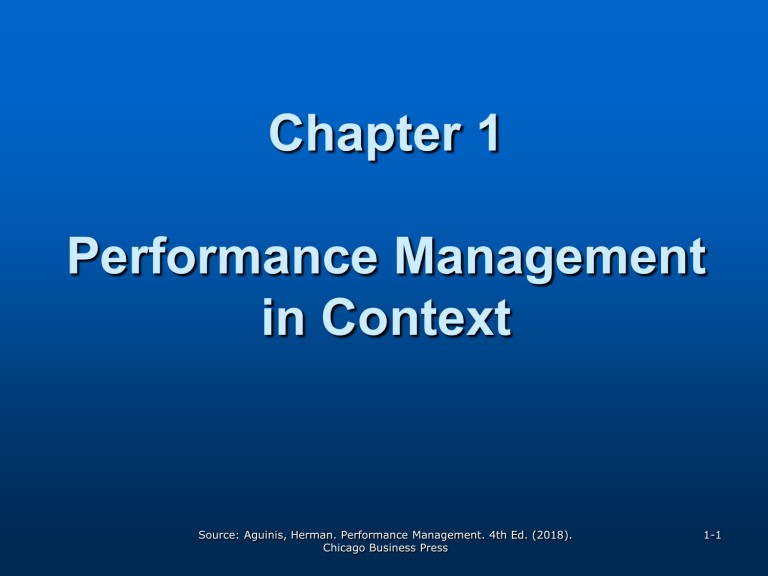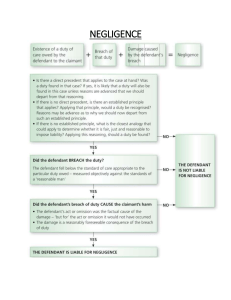
Chapter 1 Performance Management in Context Source: Aguinis, Herman. Performance Management. 4th Ed. (2018). Chicago Business Press 1-1 Overview Definition of Performance Management (PM) Purposes of PM Contributions of PM Disadvantages/Dangers of Poorly Implemented PM Systems Source: Aguinis, Herman. Performance Management. 4th Ed. (2018). Chicago Business Press 1-2 Overview (continued) Characteristics of an Ideal PM System Integration with Other Human Resources and Development Activities The Changing Nature of PM Source: Aguinis, Herman. Performance Management. 4th Ed. (2018). Chicago Business Press 1-3 Definition of PM 1. Continuous process of … • Identifying • Measuring • Developing … the performance of individuals and teams 2. Aligning performance with the strategic goals of the organization Source: Aguinis, Herman. Performance Management. 4th Ed. (2018). Chicago Business Press 1-4 Definition of PM (continued) Performance management (PM) is NOT performance appraisal (PA) Source: Aguinis, Herman. Performance Management. 4th Ed. (2018). Chicago Business Press 1-5 Definition of PM (continued) PM Strategic business considerations PA Driven by HR Assesses employee Driven by line manager Ongoing feedback • So employee can improve performance • Strengths • Weaknesses Once a year Lacks ongoing feedback Source: Aguinis, Herman. Performance Management. 4th Ed. (2018). Chicago Business Press 1-6 Performance Appraisal vs. Performance Management Performance Appraisal vs. Performance Management What did you see? What is wrong with the interaction between the supervisor and her direct report? Is this performance appraisal? Is this performance management? Why? Source: Aguinis, Herman. Performance Management. 4th Ed. (2018). Chicago Business Press 1-7 Purposes of PM Systems Source: Aguinis, Herman. Performance Management. 4th Ed. (2018). Chicago Business Press 1-8 Purposes of PM Systems Strategic Purpose Link individual goals with organization’s goals Communicate most crucial business strategic initiatives Source: Aguinis, Herman. Performance Management. 4th Ed. (2018). Chicago Business Press 1-9 Company Spotlight Sears, one of the largest U.S. retailers, is using PM to reinvigorate the company’s culture Steps include: • Revising duties and objectives • More frequent communication between supervisors and employees • Using PM to identify future leaders Source: Aguinis, Herman. Performance Management. 4th Ed. (2018). Chicago Business Press 1-10 Purposes of PM Systems Administrative Purpose Provide information for making decisions regarding: • Salary adjustments • Promotions • Retention or termination • Recognition of individual performance • Layoffs Source: Aguinis, Herman. Performance Management. 4th Ed. (2018). Chicago Business Press 1-11 Purposes of PM Systems Informational Purpose Communicate to employees: • Expectations • What is important • How they are doing • How to improve Source: Aguinis, Herman. Performance Management. 4th Ed. (2018). Chicago Business Press 1-12 Purposes of PM Systems Developmental Purpose Performance feedback/coaching Identification of individual strengths and weaknesses Identification of causes of performance deficiencies Tailor development of individual career path Source: Aguinis, Herman. Performance Management. 4th Ed. (2018). Chicago Business Press 1-13 Purposes of PM Systems Organizational Maintenance Purpose Plan effective workforce Assess future training needs Evaluate performance at organizational level Evaluate effectiveness of HR interventions Source: Aguinis, Herman. Performance Management. 4th Ed. (2018). Chicago Business Press 1-14 Purposes of PM Systems Documentation Purpose Validate selection instruments Document administrative decisions Help meet legal requirements Source: Aguinis, Herman. Performance Management. 4th Ed. (2018). Chicago Business Press 1-15 Contributions of Performance Management 1-16 Source: Aguinis, Herman. Performance Management. 4th Ed. (2018). Chicago Business Press Contributions of Performance Management For Employees For Managers For Organization/HR Function Source: Aguinis, Herman. Performance Management. 4th Ed. (2018). Chicago Business Press 1-17 Contributions of Performance Management for Employees Enhance self-insight and development Increase self-esteem Increase motivation to perform Increase employee competence Clarify definitions of • Job • Success criteria Source: Aguinis, Herman. Performance Management. 4th Ed. (2018). Chicago Business Press 1-18 Contributions of Performance Management for Managers Increase employee engagement Encourage voice behavior Minimize employee misconduct Address declines in performance early Increase employee motivation, commitment, and intentions to stay in organization Source: Aguinis, Herman. Performance Management. 4th Ed. (2018). Chicago Business Press 1-19 Contributions of Performance Management for Managers (continued) Communicate supervisors’ views of performance more clearly Managers gain insight about subordinates Better and more timely differentiation between good and poor performers Employees become more competent Source: Aguinis, Herman. Performance Management. 4th Ed. (2018). Chicago Business Press 1-20 Contributions of Performance Management for Organization / HR Function Clarify organizational goals Facilitate organizational change Fairer, more appropriate administrative actions Better protection from lawsuits Source: Aguinis, Herman. Performance Management. 4th Ed. (2018). Chicago Business Press 1-21 Disadvantages/Dangers of Poorly Implemented PM Systems For Employees For Managers For Organization/HR Function Source: Aguinis, Herman. Performance Management. 4th Ed. (2018). Chicago Business Press 1-22 Disadvantages/Dangers of Poorly Implemented PM Systems Source: Aguinis, Herman. Performance Management. 4th Ed. (2018). Chicago Business Press 1-23 Disadvantages/Dangers of Poorly Implemented PM Systems for Employees Lowered self-esteem Employee burnout and job dissatisfaction Damaged relationships Use of false or misleading information Source: Aguinis, Herman. Performance Management. 4th Ed. (2018). Chicago Business Press 1-24 Disadvantages/Dangers of Poorly Implemented PM Systems for Managers Increased turnover Decreased motivation to perform Unjustified demands on managers’ resources Varying and unfair standards and ratings Source: Aguinis, Herman. Performance Management. 4th Ed. (2018). Chicago Business Press 1-25 Disadvantages/Dangers of Poorly Implemented PM Systems for Organization/HR Function Wasted time and money Unclear ratings system Emerging biases Increased risk of litigation Source: Aguinis, Herman. Performance Management. 4th Ed. (2018). Chicago Business Press 1-26 Disadvantages/Dangers of Poorly Implemented PM Systems for Organization/HR Function Wasted time and money Unclear ratings system Emerging biases Increased risk of litigation Source: Aguinis, Herman. Performance Management. 4th Ed. (2018). Chicago Business Press 1-27 Company Spotlight Yahoo was subject to a lawsuit due to a poorly implemented performance management system Missteps include: • Forced ranking of employees • Unclear ratings and lack of openness • Biases including gender discrimination Source: Aguinis, Herman. Performance Management. 4th Ed. (2018). Chicago Business Press 1-28 Company Spotlight Adobe implemented a state-ofthe-science performance management system Benefits included: • Time savings (80,000 hours) • Increased morale • Decreased turnover Source: Aguinis, Herman. Performance Management. 4th Ed. (2018). Chicago Business Press 1-29 Characteristics of an Ideal PM System Source: Aguinis, Herman. Performance Management. 4th Ed. (2018). Chicago Business Press 1-30 An Ideal PM System: 15 Characteristics Strategically Congruent Consistent with organization’s strategy Aligned with unit and organizational goals Source: Aguinis, Herman. Performance Management. 4th Ed. (2018). Chicago Business Press 1-31 An Ideal PM System: 15 Characteristics Contextually Congruent Congruent with the organization’s culture as well as the broader cultural context of the region or country • Example: A 360-degree feedback is not effective where communication is not fluid and hierarchies are rigid Source: Aguinis, Herman. Performance Management. 4th Ed. (2018). Chicago Business Press 1-32 An Ideal PM System: 15 Characteristics Thorough All employees are evaluated All major job responsibilities are evaluated Evaluations cover performance for entire review period Feedback is given on both positive and negative performance Source: Aguinis, Herman. Performance Management. 4th Ed. (2018). Chicago Business Press 1-33 An Ideal PM System: 15 Characteristics Practical Available Easy to use Acceptable to decision makers Benefits outweigh costs Source: Aguinis, Herman. Performance Management. 4th Ed. (2018). Chicago Business Press 1-34 An Ideal PM System: 15 Characteristics Meaningful Standards are important and relevant System measures ONLY what employee can control Results have consequences Evaluations occur regularly and at appropriate times System provides for continuing skill development of evaluators Source: Aguinis, Herman. Performance Management. 4th Ed. (2018). Chicago Business Press 1-35 An Ideal PM System: 15 Characteristics Specific Concrete and detailed guidance to employees • What’s expected • How to meet the expectations Source: Aguinis, Herman. Performance Management. 4th Ed. (2018). Chicago Business Press 1-36 An Ideal PM System: 15 Characteristics Identifies effective and ineffective performance Distinguish between effective and ineffective: • Behaviors • Results Provide ability to identify employees with various levels of performance. Source: Aguinis, Herman. Performance Management. 4th Ed. (2018). Chicago Business Press 1-37 An Ideal PM System: 15 Characteristics Reliable Consistent Free of error Inter-rater reliability Source: Aguinis, Herman. Performance Management. 4th Ed. (2018). Chicago Business Press 1-38 An Ideal PM System: 15 Characteristics Valid Relevant (i.e., measures what is important) Not deficient (i.e., doesn’t measure unimportant facets of job) Not contaminated (i.e., only measures what the employee can control) Source: Aguinis, Herman. Performance Management. 4th Ed. (2018). Chicago Business Press 1-39 An Ideal PM System: 15 Characteristics Acceptable and Fair Perception of Distributive Justice • Work performed Evaluation received Reward Perception of Procedural Justice • Fairness of procedures used to: Determine ratings Link ratings to rewards Source: Aguinis, Herman. Performance Management. 4th Ed. (2018). Chicago Business Press 1-40 An Ideal PM System: 15 Characteristics Acceptable and Fair Perception of Interpersonal Justice • Perceptions of quality of the design and implementation of the PM system Perception of Informational Justice • Performance expectations and goals • Feedback received • Information given to justify administrative decisions Source: Aguinis, Herman. Performance Management. 4th Ed. (2018). Chicago Business Press 1-41 An Ideal PM System: 15 Characteristics Inclusive Represents concerns of all involved • When system is created, employees should help with deciding: What should be measured How it should be measured • Employee should provide input on performance prior to evaluation meeting. Source: Aguinis, Herman. Performance Management. 4th Ed. (2018). Chicago Business Press 1-42 An Ideal PM System: 15 Characteristics Open (No Secrets) Frequent, ongoing evaluations and feedback Two-way communications in appraisal meeting Clear standards and ongoing communication Communications are factual, open, and honest Source: Aguinis, Herman. Performance Management. 4th Ed. (2018). Chicago Business Press 1-43 An Ideal PM System: 15 Characteristics Correctable Recognizes that human judgment is fallible Appeals process provided Source: Aguinis, Herman. Performance Management. 4th Ed. (2018). Chicago Business Press 1-44 An Ideal PM System: 15 Characteristics Standardized Ongoing training of managers to provide consistent evaluations across: • People • Time Source: Aguinis, Herman. Performance Management. 4th Ed. (2018). Chicago Business Press 1-45 An Ideal PM System: 15 Characteristics Ethical Supervisor suppresses self-interest Supervisor rates only where (s)he has sufficient information about the performance dimension Supervisor respects employee privacy Source: Aguinis, Herman. Performance Management. 4th Ed. (2018). Chicago Business Press 1-46 Integration with other Human Resources and Development Activities PM provides information for: • Development of training to meet organizational needs • Workforce planning • Recruitment and hiring decisions • Development of compensation systems Source: Aguinis, Herman. Performance Management. 4th Ed. (2018). Chicago Business Press 1-47 Changing Nature of PM PM is changing rapidly due to: Technological Advancements Globalization Demographic Changes Source: Aguinis, Herman. Performance Management. 4th Ed. (2018). Chicago Business Press 1-48 Changing Nature of PM Technological Advancements Use of cloud computing for real-time and constant feedback Availability of Big Data and use of Electronic Performance Monitoring (EPM) Source: Aguinis, Herman. Performance Management. 4th Ed. (2018). Chicago Business Press 1-49 Changing Nature of PM Globalization Increasing prevalence of virtual teams located across the world Need to consider local norms— including societal and organizational cultural issues Source: Aguinis, Herman. Performance Management. 4th Ed. (2018). Chicago Business Press 1-50 Changing Nature of PM Demographic Changes Retirement of baby boomers and influx of Gen X and Gen Y (Millennials) Source: Aguinis, Herman. Performance Management. 4th Ed. (2018). Chicago Business Press 1-51 Millennials in the Workforce Millennials in the Workforce What are some of the stereotypes associated with Millennials and how would you manage them? Which of these stereotypes have been particularly exaggerated? Source: Aguinis, Herman. Performance Management. 4th Ed. (2018). Chicago Business Press 1-52 Quick Review Definition of Performance Management (PM) Purposes of PM Systems Contributions of PM Disadvantages/Dangers of Poorly Implemented PM Systems Characteristics of an Ideal PM System Integration with Other Human Resources and Development Activities Changing Nature of PM 1-53 Source: Aguinis, Herman. Performance Management. 4th Ed. (2018). Chicago Business Press






